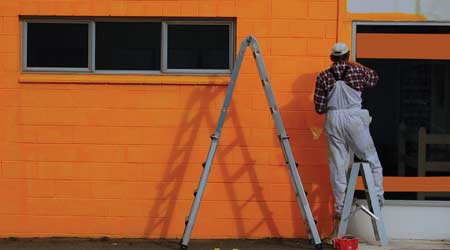 Painters dealing with an array of substrates should plan projects with preparation, application and cleanup in mind in order to produce quality, lasting jobs.
Painters dealing with an array of substrates should plan projects with preparation, application and cleanup in mind in order to produce quality, lasting jobs.Paints and Coatings: Primer Pointers
By understanding paint and coating options and surface challenges, managers can deliver successful applications
Manufacturers offer an application sheet with each paint and coating product that describes the substrate for which the product is formulated. Using color-matching tools provided by manufacturers, painters can accurately match any color.
Whether using a PC, mobile device, or tablet, the user can match colors from anywhere. To reduce inventory costs, they can use this matching capability with white paint to achieve any color in the exact amount needed. Color calculators enable quick comparison of many combinations of trim and surface colors and decorative finishes.
Primer Pointers
While maintenance managers understandably focus most of their specification efforts on selecting a topcoat, primer paints can help ensure the success of an application, since they are formulated to adhere to surfaces and form a binding layer that is better prepared to receive the paint.
Primer selection varies with the type and condition of the substrate. For example, if steel rust remains after scraping and wire brushing, a primer with fish oil will bind well. Primers perform many functions in addition to providing a good substrate bond and a good base for the finish coat. They can seal stains well, apply easily, be recoated in two hours, have zero volatile organic compounds and have antimicrobial properties. Zinc chromate primers bind to galvanized metal.
With a proper primer, workers can apply many types of paints that will bond well to any substrate. It is important that the primer and paint are compatible. This feature reduces the number of different types of paint that departments must keep in inventory. Instead of storing alkyd, acrylic, acrylic latex, latex, and oil paints, workers only need to exterior and interior paints.
To ensure worker safety, paints and coating safety data sheets (SDS) must be readily available for those near where paint is stored and mixed. An SDS shows if the paint is hazardous. For example, titanium dioxide, frequently used in paints for its brightening properties, contains carcinogens.
The SDS also shows if the product is safer brushed or rolled. When spraying paints, workers must wear proper personal protective equipment, such as a suitable respirator, in order to keep this spray out of the lungs.
Thomas A. Westerkamp is a maintenance and engineering management consultant and president of the work management division of Westerkamp Group LLC.
Related Topics:














